"I wrote my abstract, sent it in,
With words that don’t offend.
Imagine my horror to find that I
Am scheduled at the end.
Imagine my horror to find that I
Am scheduled at the end.
Let me say, to be last speaker,
There are very few things worse.
And so this talk, to get revenge,
Will be entirely in verse.
There are very few things worse.
And so this talk, to get revenge,
Will be entirely in verse.
The subject I address today
Is that of star formation.
And what we’ve found out recently
About the situation.
Is that of star formation.
And what we’ve found out recently
About the situation.
Stars start out as clouds of gas and
Dust and bits of spinning stuff.
Collapsing gravitationally
Until they’re dense enough.
Dust and bits of spinning stuff.
Collapsing gravitationally
Until they’re dense enough.
They form themselves in little lumps,
(Or so says this bloke Jeans).
‘Dynamic Instabilities’
Whatever that term means.
(Or so says this bloke Jeans).
‘Dynamic Instabilities’
Whatever that term means.
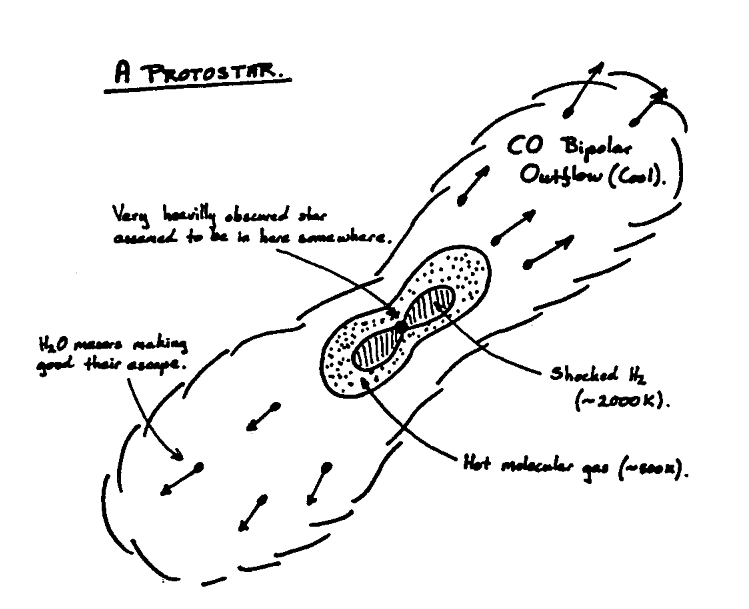
A protostar is thus created,
Igniting nuclear fuel.
Before too long the star begins
To really lose its cool.
Igniting nuclear fuel.
Before too long the star begins
To really lose its cool.
A massive wind begins to blow;
No one’s quite sure why.
But it’s quite clear the gas and stuff
Begins to really fly.
No one’s quite sure why.
But it’s quite clear the gas and stuff
Begins to really fly.
Well, from all this result what’s called
Protostellar outflow.
Bipolar, fast, and hot as hell —
We see it in CO.
Protostellar outflow.
Bipolar, fast, and hot as hell —
We see it in CO.
But radio can’t tell us much;
There are but few transitions,
And cool CO’s so common, it
Confuses most positions.
There are but few transitions,
And cool CO’s so common, it
Confuses most positions.
So, most of what we know of this
Comes from the infrared —
That bit of spectrum in the middle
That decent people dread
Comes from the infrared —
That bit of spectrum in the middle
That decent people dread
Way back in 1976,
2 Micron lines were found
In Orion where, I’m sure you know,
Molecules abound.
2 Micron lines were found
In Orion where, I’m sure you know,
Molecules abound.
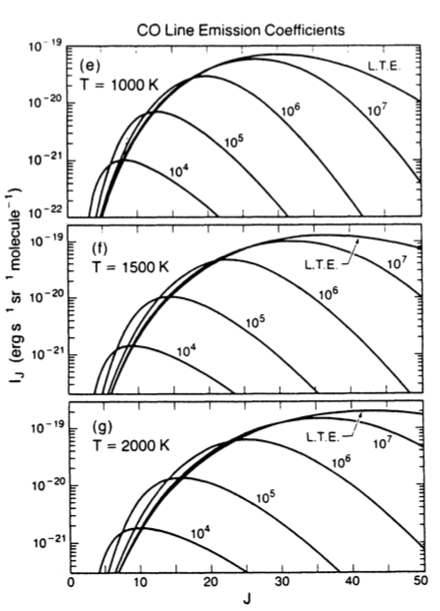
Now everyone was most surprised,
These lines put out much power.
No one thought they’d be that strong —
Not even Neugebauer.
These lines put out much power.
No one thought they’d be that strong —
Not even Neugebauer.
The lines were due to hydrogen
Molecules, and they
Don’t emit much until heated
To at least two thousand K
Molecules, and they
Don’t emit much until heated
To at least two thousand K
Well, people studied this for years,
Finding H2 everywhere.
But still these lines don’t tell you what
Density is there.
Finding H2 everywhere.
But still these lines don’t tell you what
Density is there.
What we need’s another line:
Density dependent.
This view needs no genius
In order to defend it.
Density dependent.
This view needs no genius
In order to defend it.
I’ve talked for several minutes now,
(I’ve half an hour to go),
I’m sure you’re most surprised I haven’t
Mentioned yet the KAO
(I’ve half an hour to go),
I’m sure you’re most surprised I haven’t
Mentioned yet the KAO
Carbon monoxide, really hot,
Has heaps of good transitions
Depending critically upon
The density conditions.
Has heaps of good transitions
Depending critically upon
The density conditions.
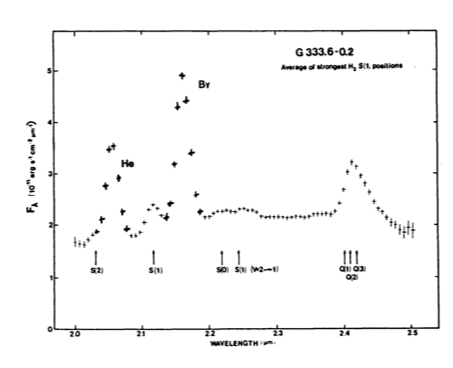
These lines are in the far — IR,
But wait — here’s the best bit –
To see them you will need to use
The KAO, you guessed it!
But wait — here’s the best bit –
To see them you will need to use
The KAO, you guessed it!
In 1980, from the plane, we
Found it in Orion,
But no more CO could we find
Despite long hours of flyin’.
Found it in Orion,
But no more CO could we find
Despite long hours of flyin’.
So models of Orion’s shock
Were looking really grand,
But it remained the only source
We claimed to understand.
Were looking really grand,
But it remained the only source
We claimed to understand.
We needed several other sources,
All of which we’d then compare.
But when we looked for shocked CO,
We always found it wasn’t there.
All of which we’d then compare.
But when we looked for shocked CO,
We always found it wasn’t there.
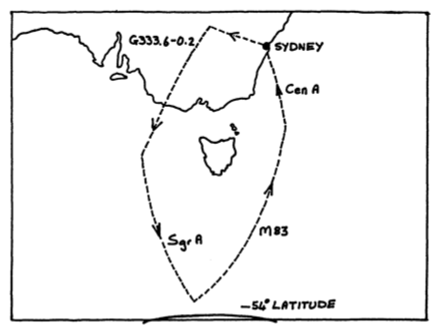
And so I searched for southern sources
Of this shocked H2,
And found it, in G333
Point six, minus, naught point two.
Of this shocked H2,
And found it, in G333
Point six, minus, naught point two.
It’s really very, very bright
And made us all quite happy.
The data’s good, the lines are strong
(Though the slide don’t look real snappy.)
And made us all quite happy.
The data’s good, the lines are strong
(Though the slide don’t look real snappy.)
So, if we want to search again
For shocked CO, and wouldn’t you?
What better place than G333
Point six, minus, naught point two!
For shocked CO, and wouldn’t you?
What better place than G333
Point six, minus, naught point two!
The problem with this new-found source,
I hardly need to warn you,
Is that it’s too far south to see
From sunny California.
I hardly need to warn you,
Is that it’s too far south to see
From sunny California.
And so to us the Kuiper came;
In May last year it made it.
The cost was astronomical,
But NASA mainly paid it.
In May last year it made it.
The cost was astronomical,
But NASA mainly paid it.
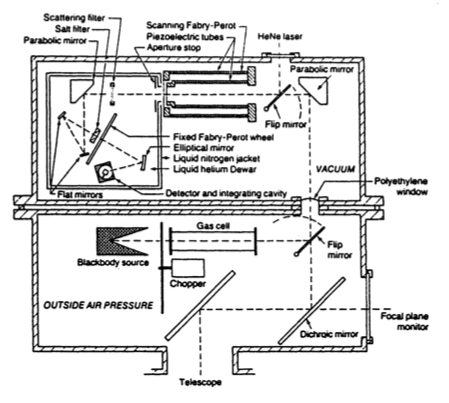
Thus we made a set of flights
From Richmond Airforce Base.
One such flight is shown right here:
Our tracks’s this dotted trace.
From Richmond Airforce Base.
One such flight is shown right here:
Our tracks’s this dotted trace.
How the instrument is made
Upon this slide is told;
It uses liquid helium
To keep all these bits cold.
Upon this slide is told;
It uses liquid helium
To keep all these bits cold.
Well, here’s the data — please don’t laugh,
It often looks this way.
A few times through the VAX and then
We’ll publish it as Ap J.
It often looks this way.
A few times through the VAX and then
We’ll publish it as Ap J.
The line is there, I kid you not,
This dip here’s just the sky.
To see the peak you simply need
A good impartial eye.
This dip here’s just the sky.
To see the peak you simply need
A good impartial eye.
Least-squares fitting gives a curve
From which derive the facts.
(Oh, let me thank the AAO
For lending me their VAX.)
From which derive the facts.
(Oh, let me thank the AAO
For lending me their VAX.)
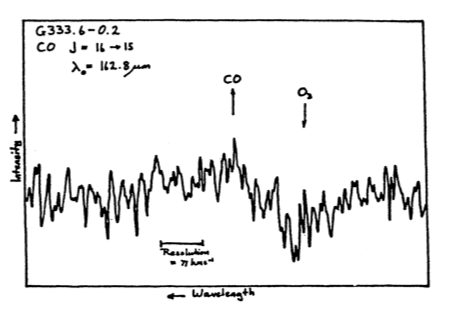
Vlsr is fifty-three.
It’s pleasing, as you see.
The radio line velocities
More or less agree.
It’s pleasing, as you see.
The radio line velocities
More or less agree.
Intensity is really weak:
It’s two point nought by ten.
To the minus eighteenth power
(In watts per square cm.)
It’s two point nought by ten.
To the minus eighteenth power
(In watts per square cm.)
That’s thirty times as weak as we
Detected in Orion.
No wonder it took several years
Of concentrated tryin’
Detected in Orion.
No wonder it took several years
Of concentrated tryin’
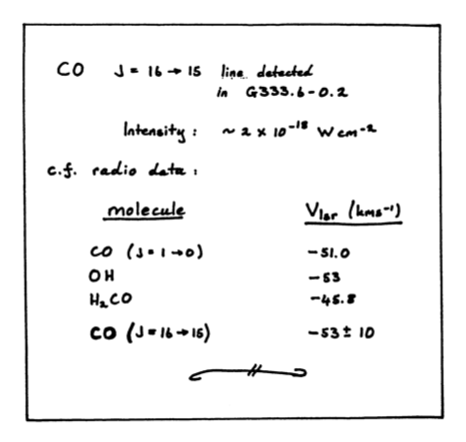
Well, as you see, I don’t yet have
Any numbers clear
For density, and things like that.
(It’s only been a year.)
Any numbers clear
For density, and things like that.
(It’s only been a year.)
But now we have not one, but two
CO sources, it is true:
Orion, and this G333
Point six, minus, naught point two.
CO sources, it is true:
Orion, and this G333
Point six, minus, naught point two.
In fact, the sources now are three
Because, again last May,
The very next flight that we did
Found CO in Sgr A.
Because, again last May,
The very next flight that we did
Found CO in Sgr A.
Well, thank you all for listening
(Though some of you have slept)
I wonder now, will Dick McGee
This manuscript accept?"
(Though some of you have slept)
I wonder now, will Dick McGee
This manuscript accept?"
No comments:
Post a Comment